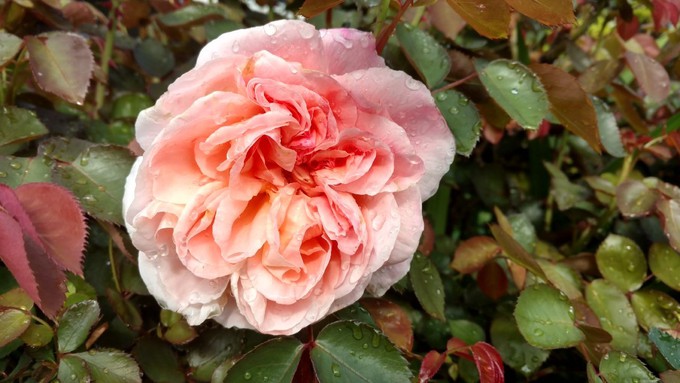
American Rose Society offers free webinar on flower photography

This Tamora rose in the rain was photographed by Debbie Arrington, who has taken Jacqui Nye's class. Debbie Arrington
Rose photographer and exhibitor Jacqui Nye grows lots of other flowers in her Rhode Island garden, too, but roses are her favorite to shoot and share.
She’s not alone; roses are the No. 1 flower on Instagram. By a recent count, more than 80 million Instagram posts feature rose photos, along with the hashtag #rose or #roses. (A distant second are sunflowers at 15.5 million.)
Smartphone and iphones make capturing roses anytime, anywhere a snap. But some simple rules of composition can make a huge difference in results. As Nye says, “you can turn a snapshot into a wow shot.”
Nye recently gave this photo presentation in Sacramento during the American Rose Society’s district conference. Her talk was filled with easy tips for even beginning photographers.
At 11 a.m. Saturday, March 9, Nye will expand on that workshop for an online audience. Part of a series of ARS webinars, this presentation will be two hours, twice as long as her Sacramento talk.
Registration is free and open to anyone, not just ARS members. And Nye’s advice applies to all flowers, not just roses.
Advance registration is required. Sign up here: https://register.gotowebinar.com/register/174998707400148828
Comments
0 comments have been posted.Sacramento Digs Gardening to your inbox.
Food in My Back Yard Series
May 6: Maintain soil moisture with mulch for garden success
April 29: What's (already) wrong with my tomato plants?
April 22: Should you stock up on fertilizer? (Yes!)
April 15: Grow culinary herbs in containers
April 8: When to plant summer vegetables
April 1: Don't be fooled by these garden myths
March 25: Fertilizer tips: How to 'feed' your vegetables for healthy growth
March 18: Time to give vegetable seedlings some more space
March 11: Ways to win the fight against weeds
March 4: Potatoes from the garden
Feb. 25: Plant a fruit tree now -- for later
Feb. 18: How to squeeze more food into less space
Feb. 11: When to plant? Consider staggering your transplants
Feb. 4: Starting in seed starting
Sites We Like
Garden Checklist for week of May 11
Make the most of the lower temperatures early in the week. We’ll be back in the 80s by Thursday.
* Plant, plant, plant! It’s prime planting season in the Sacramento area. Time to set out those tomato transplants along with peppers and eggplants. Pinch off any flowers on new transplants to make them concentrate on establishing roots instead of setting premature fruit.
* Direct-seed melons, cucumbers, summer squash, corn, radishes, pumpkins and annual herbs such as basil.
* Harvest cabbage, lettuce, peas and green onions.
* In the flower garden, direct-seed sunflowers, cosmos, salvia, zinnias, marigolds, celosia and asters. (You also can transplant seedlings for many of the same flowers.)
* Plant dahlia tubers.
* Transplant petunias, marigolds and perennial flowers such as astilbe, columbine, coneflowers, coreopsis, dahlias, rudbeckia and verbena.
* Keep an eye out for slugs, snails, earwigs and aphids that want to dine on tender new growth.
* Feed summer bloomers with a balanced fertilizer.
* For continued bloom, cut off spent flowers on roses as well as other flowering plants.
* Add mulch to the garden to maintain moisture. Mulch also cuts down on weeds. But don’t let it mound around the stems or trunks of trees or shrubs. Leave about a 6-inch-to-1-foot circle to avoid crown rot or other problems.
* Remember to weed! Pull those nasties before they set seed.
* Water early in the day and keep seedlings evenly moist.